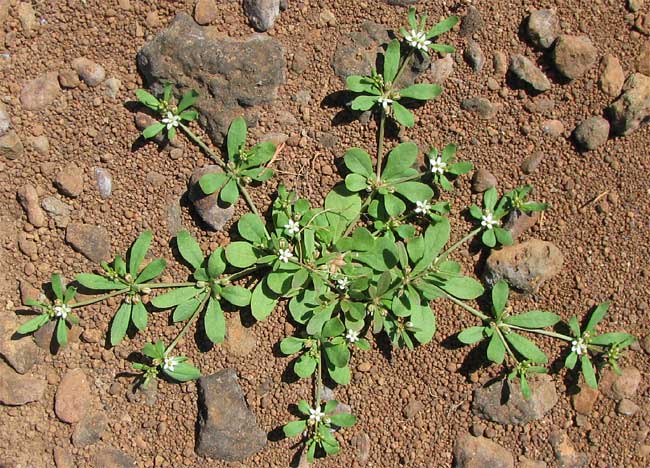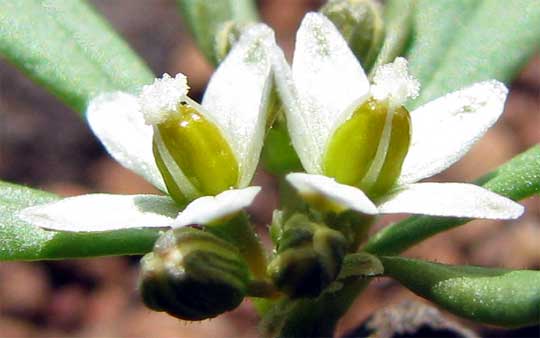Excerpts from Jim Conrad's
Naturalist Newsletter

from the the August 16, 2009 Newsletter, reporting on a visit to Lost Creek Lake in Jackson County, southwestern Oregon:
CARPETWEED
The lake was low, exposing slopes and large mudflats that each spring lie underwater. On one such stretch of exposed, barren soil I spotted an old friend, a ground-hugging little herb first met on the farm back in Kentucky, showing up in our tobacco patches where we'd have to chop it out. Also I see it a lot in Latin America, for that's where it's from originally. It's the Carpetweed, MOLLUGO VERTICILLATA, shown above.
This is a modest little plant with whorled leaves less than an inch long. I always felt bad having to remove it from the tobacco patch because clearly it wasn't competing much with the tobacco for water or nutrients. However, farmers have this thing about ANY weed in their crops. Take a look at its neat little flowers, which are only about 0.2 inch across (5 mm), below:

At first glance Carpetweed's flowers look like the super simple, super average "Standard Blossom" I use to teach basic flower anatomy at http://www.backyardnature.net/fl_stand.htm.
However, a Carpetweed flower departs from the Standard Blossom in some interesting ways. First, the flower bears no petals. The five white things looking like petals are actually sepals, which are lobes of the calyx, which usually lies green and unremarkable below the attention-getting petals. Second, the flowers in the picture bear only three pollen-producing stamens, while most flowers with five sepals or petals also bear five stamens or multiples of five. Sometimes Carpetweed flowers have four or five stamens, which also is unusual, for usually in simply flowers the stamen number is more fixed. Of course the thing looking like a green pepper in each flower's center is the ovary, which will mature into a fruit filled with many smooth, kidney-shaped seeds.
As a student I learned that Carpetweeds belong to the Stone-Plant Family, the Aizoaceae, but now gene sequencing indicates that they're so different from other plants that they deserve their own family, the Carpetweed Family, the Molluginaceae.
Carpetweeds are edible as a pot herb, but they're so small and stringy you'd have to be hard up to bother with them. The species has spread in weedy areas throughout North America except in northern Canada and Alaska.